Interview | William Stoehr
The first thing that struck me when I saw your paintings for the first time was the strength of the gesture, each drawn line seems necessary to the composition, and pushes the viewer towards the expressiveness of the eyes. Did you instinctively came up with this painting approach or was it a long training process?
To understand my style and how I got here, I think you need to go back to when I was 17 years old. That was 57 years ago and back then I wanted to be an artist. My high school art teacher introduced me to the abstract expressionist and I was hooked. But for a bunch of reasons, I did not go to art school. I went to a small state college in Northern Wisconsin and became an industrial engineer.
I didn’t paint or draw for almost 40 years. I was simply onto a different life. My wife and I had moved to the Virgin Islands and then in 2004 I woke up one day and said hey, I want to be an artist. I had a great job at National Geographic but I decided to resign. I was young enough to begin another career and why not do what I wanted to do as a teenager.
At first everything I did was too small and too tight. I did some landscapes which I didn’t like and then I did some abstracts that started to get my juices flowing and remind me how much I liked Jackson Pollock, Willem De Kooning, Franz Kline and abstract expressionism.
The abstracts were fun, decorative and they sold but they didn’t move my soul. I began to think about how I could portray more emotion and to deal with the human condition. I decided that I needed to focus on figurative work. An artist friend told me that if I wanted to learn to draw that I needed to learn to draw the human body. So I joined a couple of drawing groups and regularly worked with a live model which I continue to do on a regular basis. Then when I returned to my easel with my brushes I combined my knowledge of the figure with my love of abstract expressionism.
While my skill and style was evolving quickly, I was not building a cohesive body of work. My local art dealer told me that I painted faces well and why not paint some big faces. So I started with 4-foot faces and then 5-foot faces and then 7-foot faces.
One of the first problems I encountered with a big face was what in the world to do with the large facial areas. I mean how do I fill in a 4-foot forehead? I decided to treat these areas like separate non-objective abstract paintings. I use a range of strokes, lines, dots, drips and splashes that may or may not have any relationship to a face. I used broad strokes and lines to guide you.
Up close you see all of these various marks, but as you retreat the small details seem to vanish and the face emerges. The whole presence of these paintings is a succession of stages as you walk backwards from the painting. Some almost look photo-real.
I continue to combine broad sweeping strokes with small marks and I always emphasize the eyes. One of my early exhibits I titled Burka because of the way I obscured some areas on the face but did it in a way that you were drawn to the eyes.
This approach was simply the result of an accident as I started to brush over a painting that, while technically fine, was emotionally lacking. I saw the power of the eyes come through this mask of paint before I had a chance to brush over them. This and variations of it have become one of the characteristics of my style.
And then in the eyes, just by chance, I started using small amounts and traces of discordant colors that are complimentary, or generally opposite on the color wheel, and are of equal value or luminance.
A neuroscientist friend asked me why was I using equal luminance complimentary colors and how did I learn to do that.
Well, I said, I put a little green in and then I thought, when in doubt but purple next to green. And while I’m at it why not add a reddish-orange, the compliment of green.
People said they looked so real but, when did you see someone with orange, green and purple eyes? But my friend told me that it doesn’t matter. The color didn’t need to be accurate to seem alive. Equal value complimentary colors, even in the small amounts that I used, seemed to have an almost imperceptible but apparent liveliness about them.
Finally, I think we all know that eye contact tells us that we exist. We are drawn to eyes and so I do everything I can to exploit a shared gaze. What I quickly learned was that now that I have your attention with seemingly real and engaging eyes, I can start to do other things with line, shading and color as broad and vague outlines, caricature and unfinished sections become part of a recognizable whole. I give you some raw material along with some realistic cues and you make the person real.
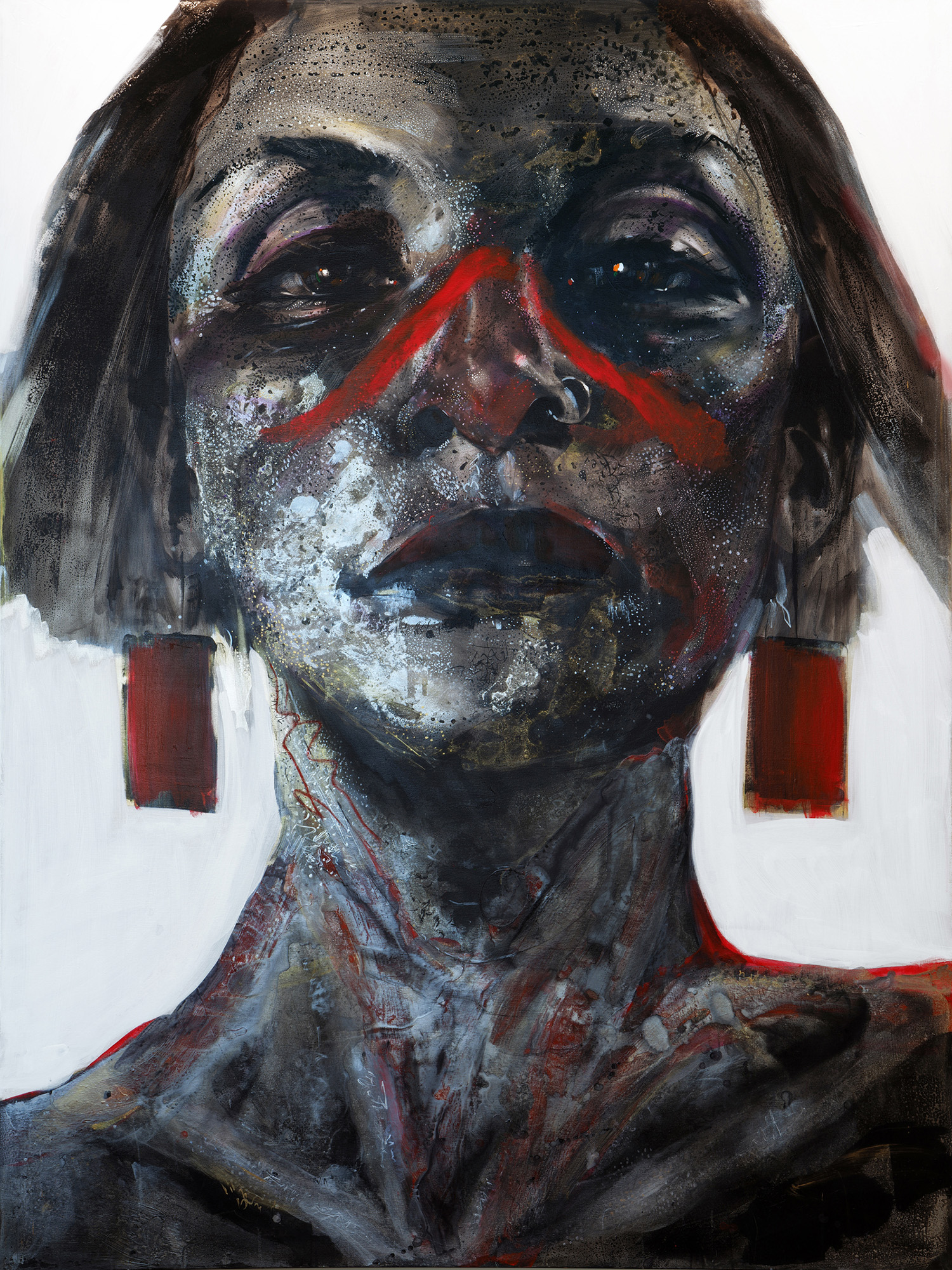
“Laine 5” | 80×60 in
Idon’t dare to imagine how many times they have already asked you, but the use of red lines is something that strongly strikes my gaze. Does it have to do with your intent to represent discrimination, and violence or does it have another meaning?
Early on I started to obscure parts of a face with the color red. Red is provocative. I try other colors, which sometimes work but, more often than not, red is most effective.
Another neuroscientist friend once told me that my red paintings stimulate two different parts of the sensory system. Consciously, you see the portrait. Subconsciously, the red slashes of paint create a mood. They are unexpected and catch your attention. You have a gut reaction before you think about it. I find it curious that red, a color associated with violence, is also the color of love. I suspect the interpretation is based on perceived context.
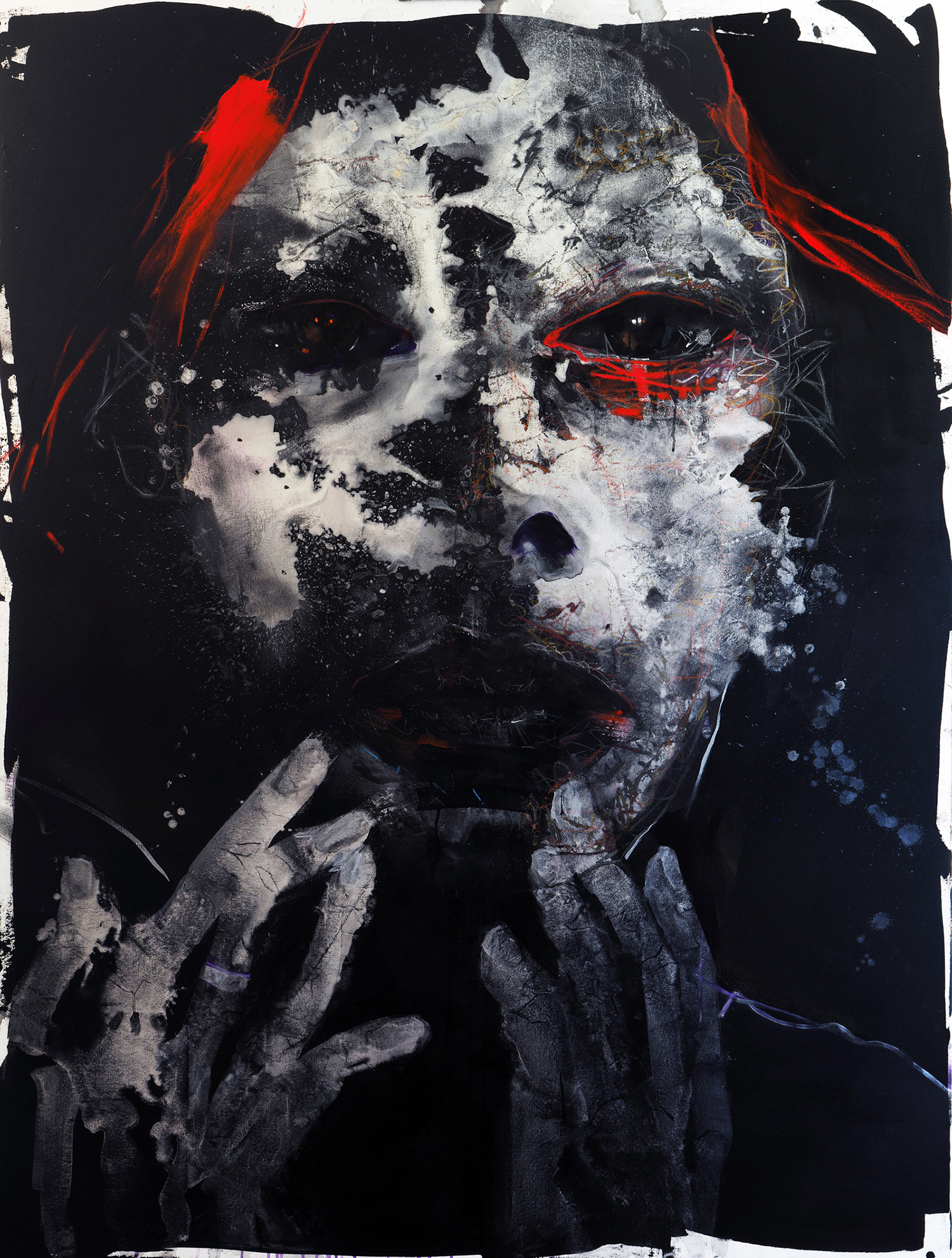
“Britain 6” | 80×60 in
Tell me something about your very initial approach, what was the emotional urgency that prompted you to create the first artworks? And now what do you think is the main engine of your artistic activity, what is the biggest thrust in your artistic production?
So now I was doing faces that people strongly reacted to but to what end? It took a few years to recognize my mission and artistic direction – to find my voice.
Well actually my voice found me and it was in the back of my head whispering….”What good is this so called art of yours?” “What does it accomplish?” “Does it really matter?” “What is the larger conversation; the wider dialog that you want to be part of?”
For me the essence of my art became the exploration of fundamental issues of our time. And my job as an artist is to get you to react, think, ask questions and respond.
I wanted to make a difference and so I started to broadly explore victims, witnesses and survivors of war, discrimination, violence, abuse, bigotry and the list went on and on and on. Viewers interpreted my work within their own subjective context related to their own experiences – which is what I wanted. But again the voice returned and asked, “How can you honestly relate to all of these issues?
Well I can’t. But I can relate to substance use disorder. Not as a victim but as a witness, and I know about stigma. My sister died of an opioid overdose. Today my art, the ideas behind it, my methods and exhibits are all focussed on helping to normalize the discussion surrounding opioids, substance use disorder and the stigma associated with it. Stigma inhibits prevention, diagnosis, treatment, and recovery. Stigma became my focus, my mission and it drives me to improve my art.
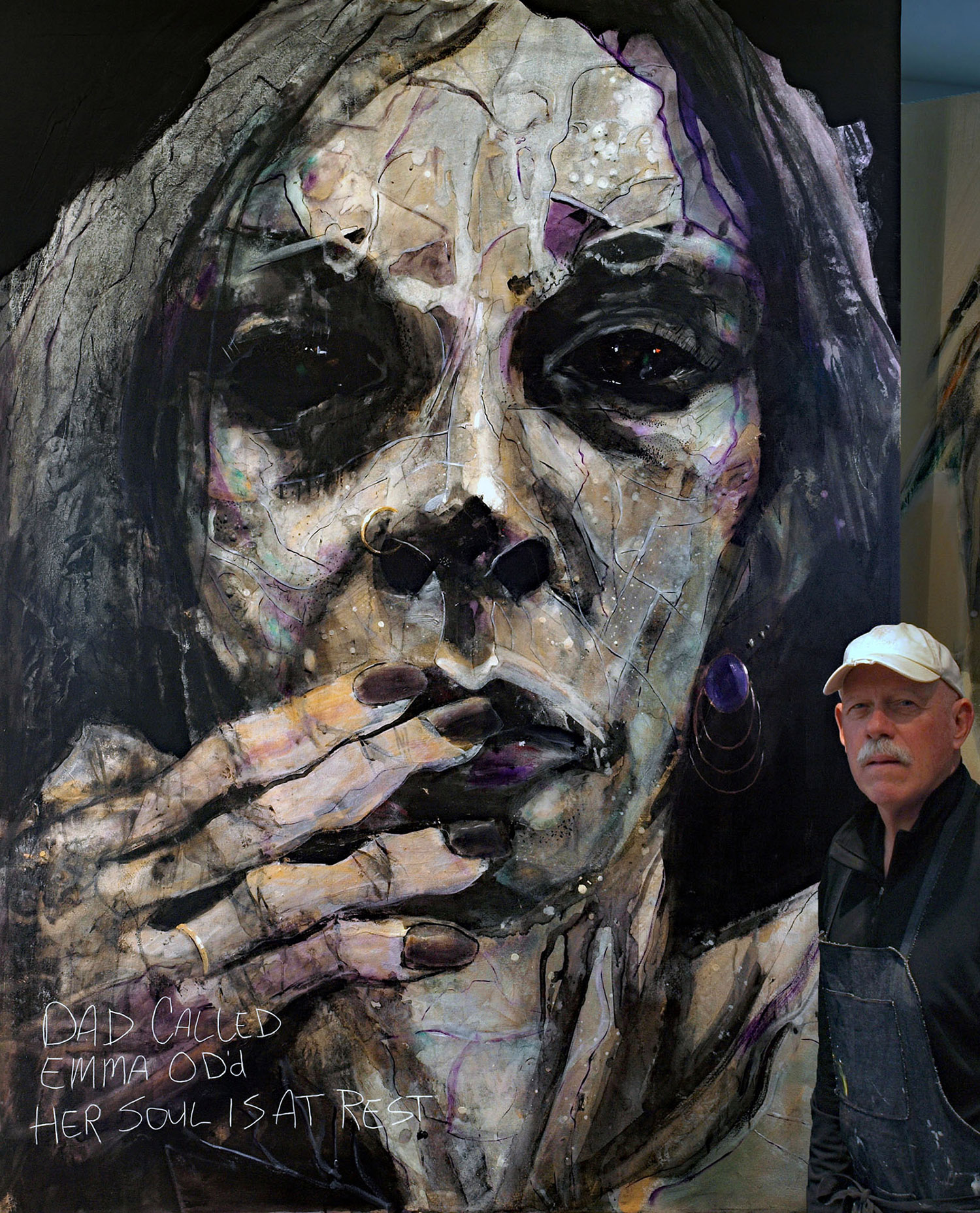
“Emma 1” | 80×60 in
Throw me for a moment in your production process for Large Faces. How do you usually start? Do you basically draw your sketches on paper or do you start from somewhere else?
My goal is to create a portrait with an ambiguous expression, shared gaze and uncertain context calculated to provoke you into creating the narrative. I typically begin with a live model and then work from reference photographs.
I start by placing an X where I want each eye, a triangle for the nose and a line for the lips. I always place them in the same relative location on each canvas so that when my portraits are hung together they work as a group. I never do preliminary sketches however I will occasionally use a line or effect that I may have discovered while drawing on my iPad.
I use a limited pallet of acrylic paint along with metallic and iridescent colors that produce changing patterns with changes in lighting and view angle. My primary tools are Bounty paper towels, a variety of brushes, charcoal, sandpaper and a Scotch-Brite kitchen scrubby.
I typically mix a metallic color (usually silver or gold) with a very watered-down black fluid acrylic and then I pour it on the canvas. Sometimes I let it run and sometimes I let it form a puddle. I lay paper towels over the paint and soak it up. I do this at varying paint-drying stages to get different patterns and effects. I apply clear acrylic and then do it all over again. I might have ten layers of metallic paint layers before I am done.
I continue to drip, brush, pour, scrub and scape paint while applying a variety of lines, dots and other adjustments. I allow accidents to direct and influence me as I create a portrait. I allow the image to emerge from the random application of paint. At soon point along the way I start to detail the eyes and possibly other facial features.
These experiments, accidents and exploitations drive what I do. It’s the practice of making and creating in the moment as a response to something – a stimulus – an idea – a challenge – maybe a drip of paint. That drip running down my canvas may be random but what I do with it is not.
 “No more words #3” | Digital Hybrid
“No more words #3” | Digital Hybrid
I’m curious about your digital hybrid artworks. What program do you use on iPad and after how long have you achieved results that you thought were comparable to your pictorial production?
Several years ago I began to seriously draw on my iPad. I use Adobe Sketch and Photoshop Elements for both my drawing and to create my digital hybrid paintings. I almost immediately achieved results that I thought were as good as my drawings and paintings on canvas. The trick of course is to take it to another level made possible by digital technology.
David Hockney is a favorite of mine. I like the way he thinks. He is always looking for new ways to present his ideas. He is always pushing boundaries in a relatable way. In 2012, I went to the David Hockney: A Bigger Picture exhibition at the Royal Academy in London. It was an expansive eye-opening visual celebration that showed me the potential for creating large-scale art on my iPad.
I now start with repurposed very high-resolution images of my own large-scale portraits, in-process work and original digital drawings. I continue to work on them on my iPad where I add various marks, masks, sound enhancements graphic overlays and animations to the base image which I then reproduce as an individual image, GIF or video. They are prepared for HD display on monitors, as projections on gallery walls, theater screens or as on-line presentations.
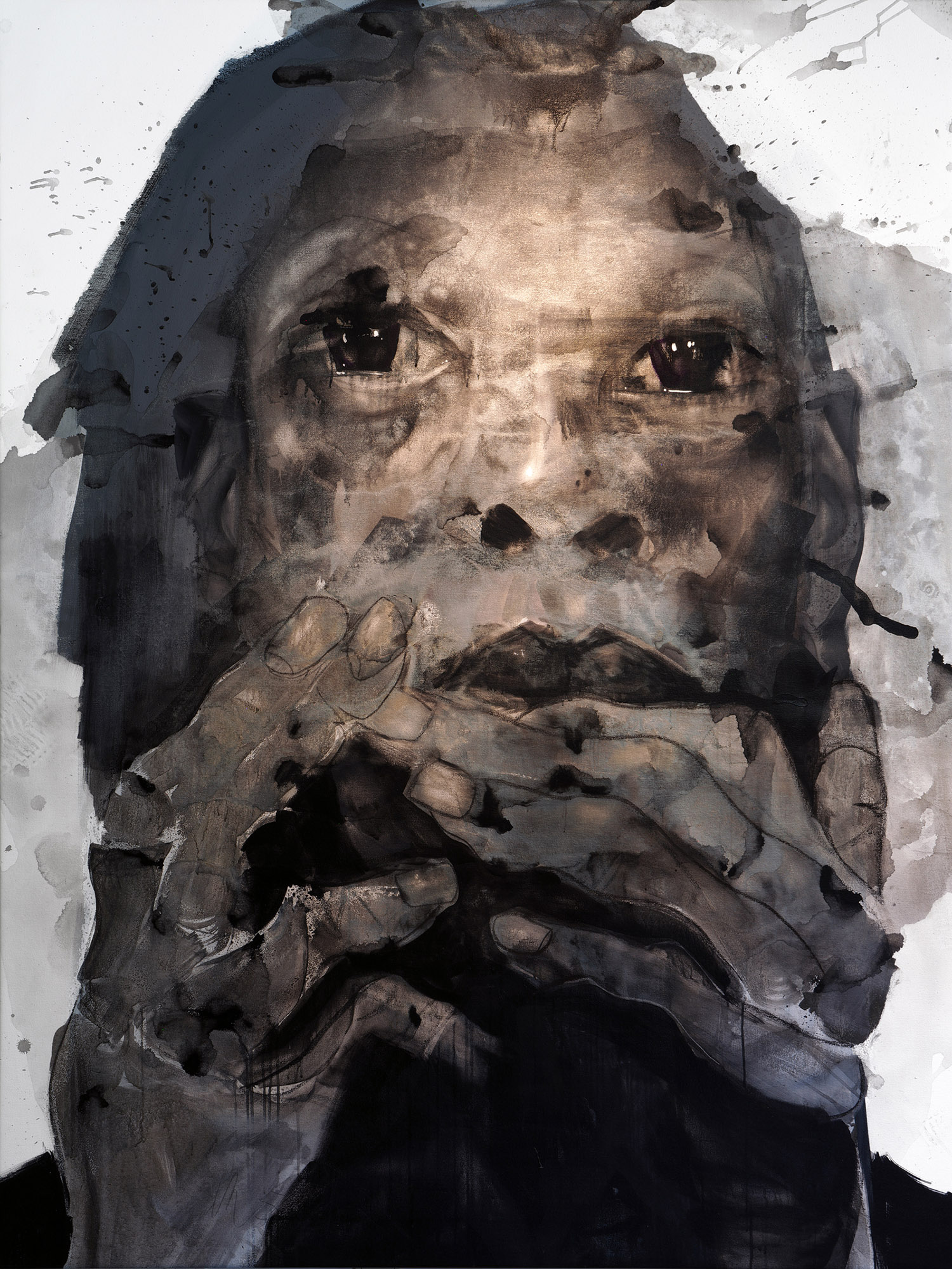
“Emma 3” | 80×60 in
How do you organize your working week? Do you have fixed days for new ideas, others for illustration process, others for promotion … or don’t you follow a pre-established schedule?
When I was working in my studio with paint and canvas I’d start my morning with a cup of coffee, read the news and then exercise for an hour or so. Then by 10am I would head to my studio and paint. I might take a lunch break and then paint until 5pm. I probably did this five days a week. Now with my digital workflow I can sit at my computer at any time. There is no preparation and no mess to clean up and so now I don’t keep such a regular schedule. I do continue to paint on canvas but not as much.
I regularly post on social media but not at scheduled times. I don’t set aside time to come up with ideas – they simply come to me at random times and I note them in my journal or on scraps of paper. I do plan to continue to draw with friends once or twice a week once we are through with Covid.

“Priscilla 10” | Digital Hybrid
How much is hard for you to promote your work? I mean, do you have a good relationship with the social media and the promotion of your works online, or is it something you consider necessary but it doesn’t convince you at all?
I am a believer in social media. I use it to try out ideas, talk about my process and connect with my followers. I use social media not so much to promote my work but to share and shape my ideas and work. I want to start conversations, to cause people to relate, respond and take action.
I have more than 300,000 social media followers. Many write to me.
One woman wrote and said that after seeing this painting of mine online, that she knew I understood her and that she wanted to die.
The next morning she looked at this very same painting and this time saw hope in the woman’s eyes and….. she then understood that she too could have hope. She said “You saved my life”.
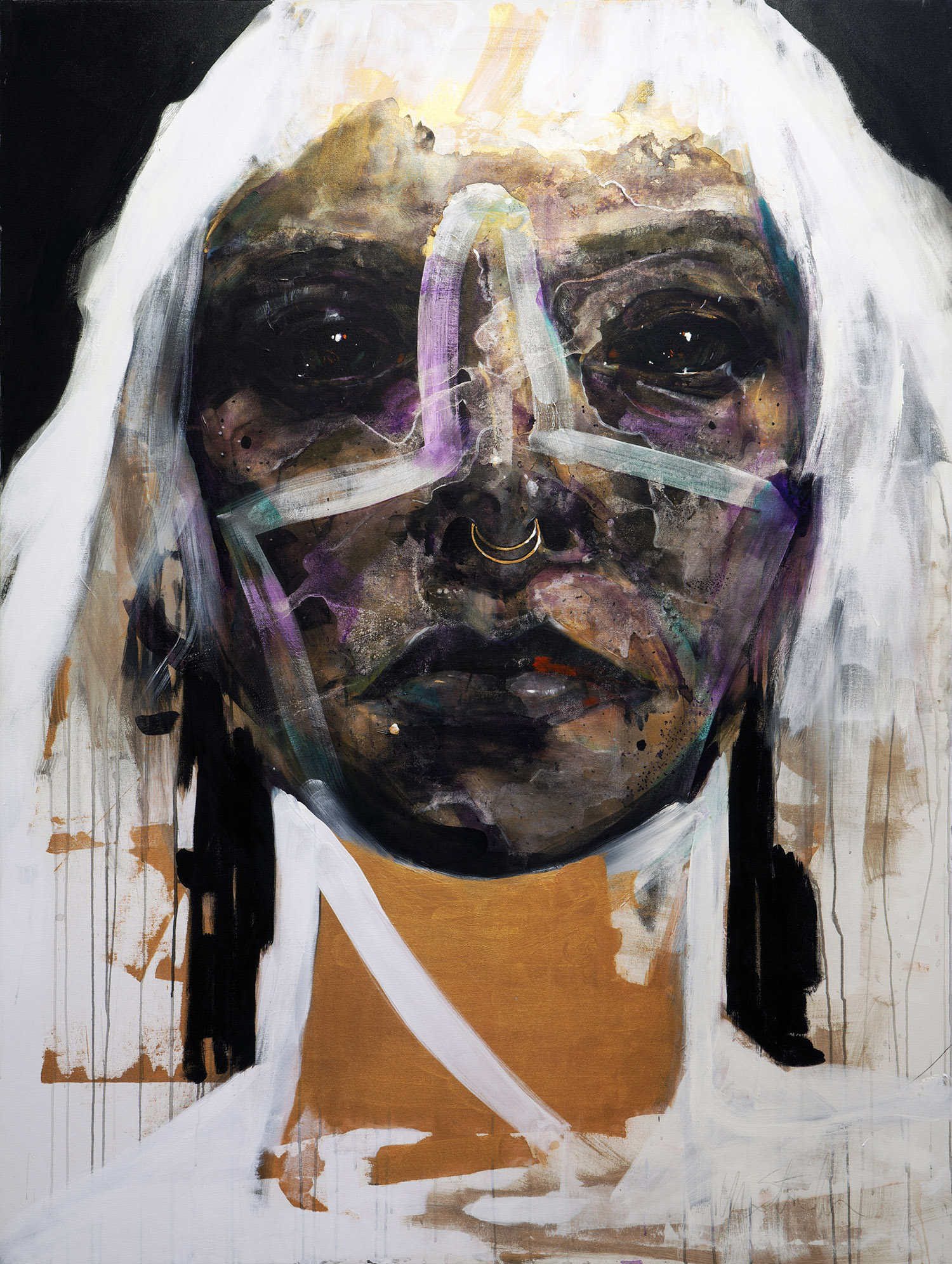
“Zoe” | 80×60 in
Nowadays it is more and more difficult to find artists who candidly declare their artistic references, even if I believe that it is the only way to stop imitating them and find their own way. At what point in your artistic career did you feel “freed” from the references that you consider important for your education.
I study art history and I am always experimenting with techniques that I have learned from other artists. I try to learn from and incorporate a certain technique or style. I don’t try to duplicate the painting, just learn about, experiment with and adapt the style. How would Franz Kline draw a face or how would De Kooning fill in an expansive forehead? I really like how Marlene Dumas spills and moves paint around and how Egon Schiele painted hands but most of all I love how Picasso thought.
Of course lots of things influence my art. Ideas seem to come out of the blue. But, I guess my art is most influenced by the ideas of Picasso and the early Cubists, as well as my interest in the visual brain.
Several years ago I went to Madrid and witnessed Picasso’s Guernica – arguably the greatest painting of the last hundred years.
Guernica exploded my brain. I heard the screams. I felt the flames melt my skin. I could smell burning flesh. I was there. I experienced a reality beyond paint and canvas. I was driven to understand how Picasso did it.
I don’t think that I will ever really understand but along the way I have discovered visual effects that other artists have used and some new ones that I stumble upon which, as it turns out, are of interest to science.
Anyhow, I study everything I can find about the early Cubists. “What were they thinking?” “What did they talk about?”
As many of us learned, most of the writing centered on the multiple viewpoints, lack of perspective and the fragmentation of forms. But as I dug deeper, I learned that it was their goal to cause you to experience a painting in a way that is more than simply observing an image – to evoke a greater reality. To make it real. They discussed how they could experience the 4th dimension – the passage of time with multiple views, memory cues and the exclusion of techniques that freeze an image in time like perspective and lighting.
Today scientists say the cubists really were on to something.
I don’t see a snapshot of you – I discern light, lines and shapes and I process them along with a wave of non-linear memory images and other cues which I recognize as you.
I think that to our common sense, this changing flow of multiple images suggests the passage of time. Sensing change may be a way that we get a taste of this greater reality.
So I try to introduce change into my art – change in expression, mood, color, shape and more. This is all designed to get you the viewer to actively participate in the creation of my work both with the visual painting and with the narrative. I want you to feel one way about the painting one moment and then another way all based on your own state-of-mind partially influenced by the cues I present you.
Once I understood this I began exploring other ways to cause you the viewer to experience a greater reality of your own making. One such way is what neuroscientists call higher-level ambiguity.
Higher level ambiguity creates a vacuum that you want to fill and you will do a better job than I can, creating and recreating the painting and narrative with your own perfect mental image and projected emotions.
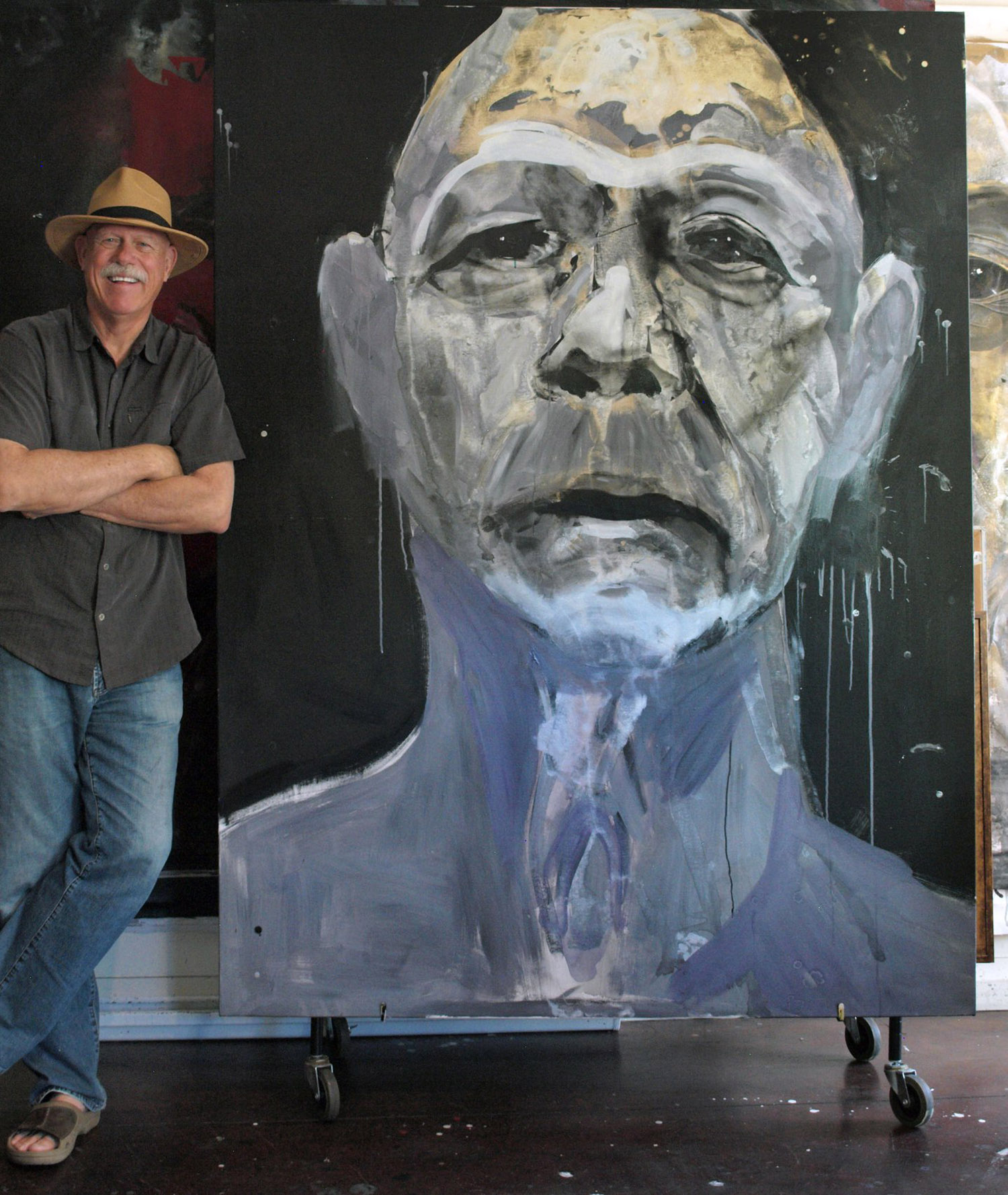
“Willie 12” | 80×60 in
Let’s play with time for a minute: you’ve booked a dinner table for 4, and you can invite whomever you want from Ramses II to Billie Eilish. Tell me your DDT, Dinner Dream Team.
Pablo Picasso, John Lennon, Mother Theresa.
Here we go, Proust Questionnaire: Your favorite virtue?
Love – it’s the starting point for everything good.
Your main fault?
Too quick to judge – sometimes it’s just better to keep your mouth shut.
Your idea of happiness?
I love sharing experiences with my wife, son and his family. Today, I am especially joyful when being with my grandsons. I am also happy, not sure if that is the right word, when in that zone where time stands still when I have a brush in my hand.
If not yourself, who would you be?
Vincent van Gogh
How you wish to die?
Either when I am 99 years old while I sleep or with a bullet through my head while doing something heroic.
What is your present state of mind?
Upbeat and happy.
Our time is running out, let’s leave ourselves with your vision for the future. Please tell me the projects you would like to achieve in the near future, and something you would finally get rid of?
Oh I certainly have some exhibition ideas. I would love to have a show of my large self-portraits and of course I am always interested in showing my work that relates to opioids and substance use disorder.
But as far as new production, for me the future is digital. I consider myself a traditional artist now incorporating technology into my practice. I believe that my hybrid digital painting is a way to take my art to a new level and to more effectively get my message out to those that matter most. Now I can better reach more than 300,000 people that follow me on social media and I can easily send digital images and videos to collaborators for both on-line and physical exhibitions.
All images courtesy of William Stoehr: Website | Instagram

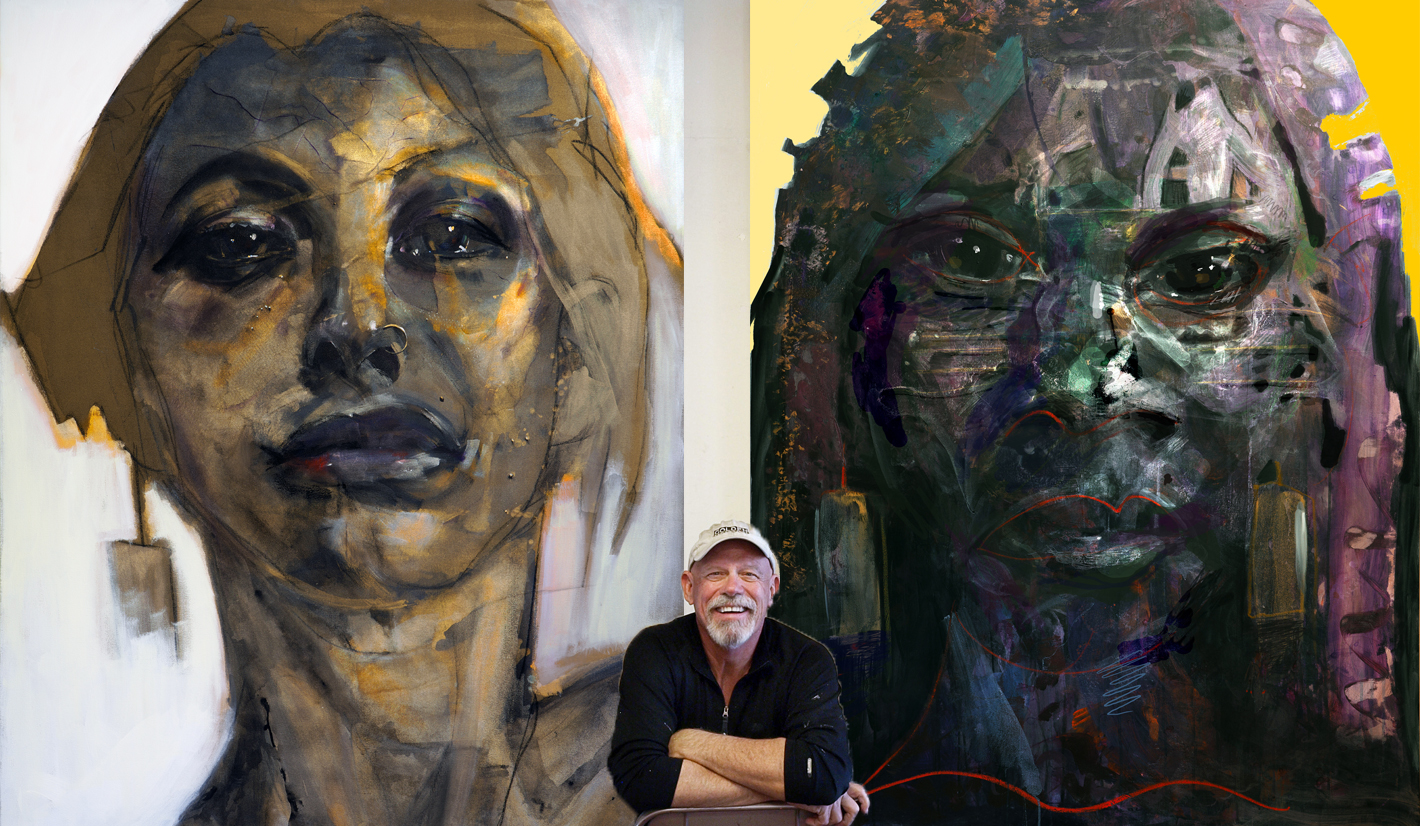
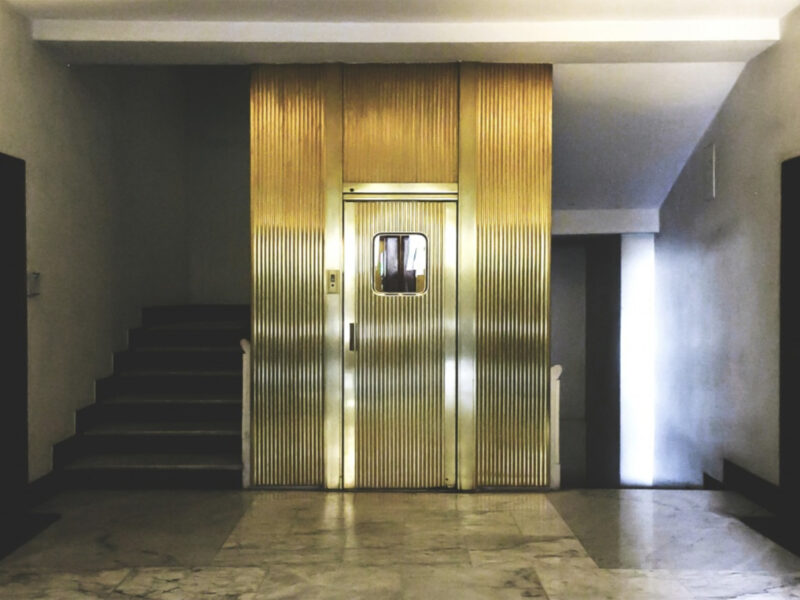
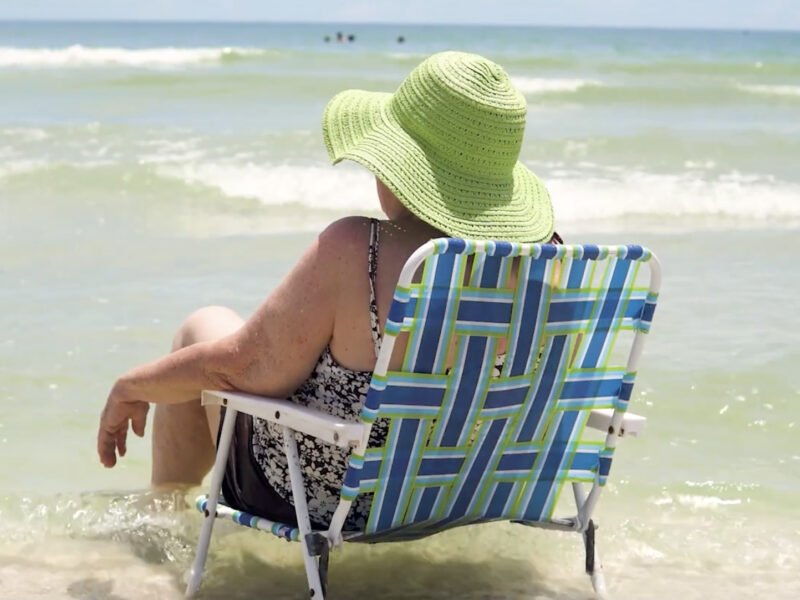
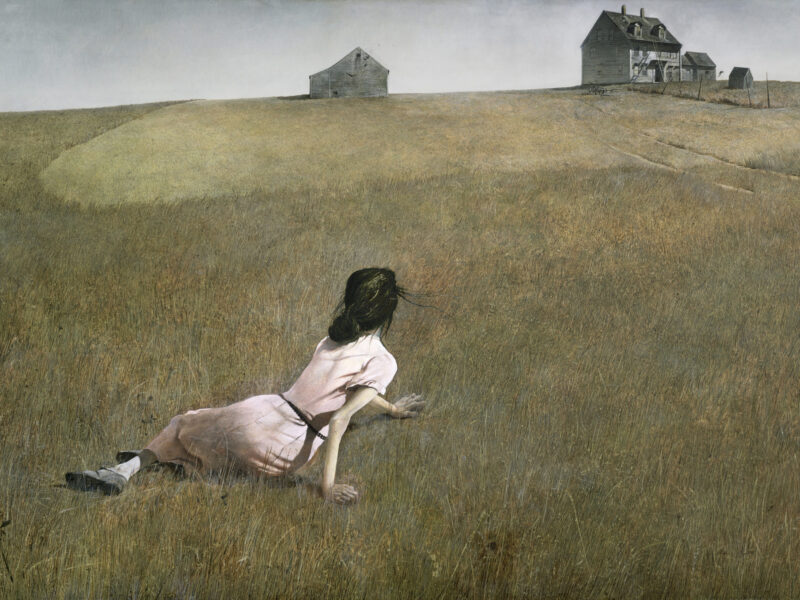

Barbara Maloy
We just heard from a true artist who genuinely knows himself.